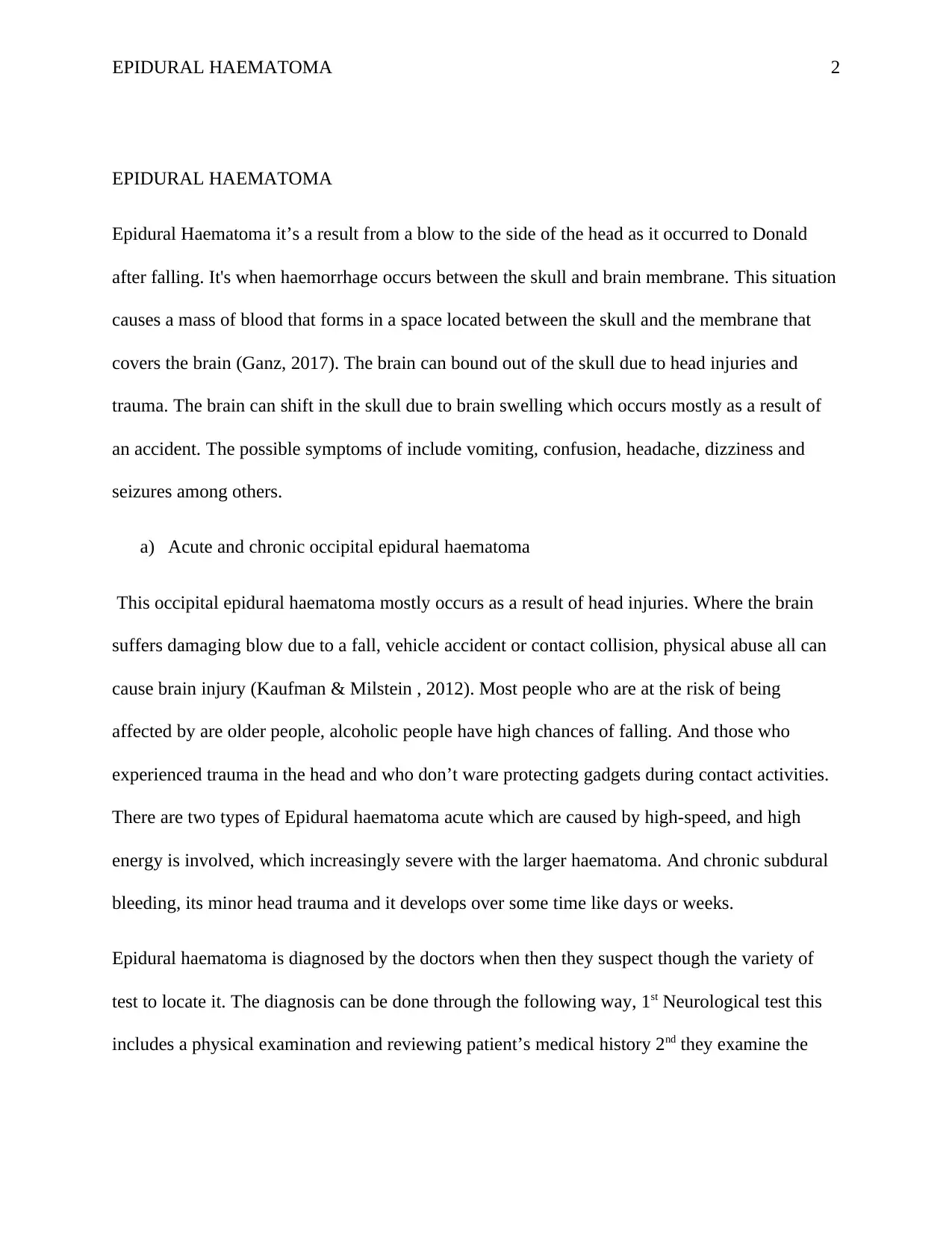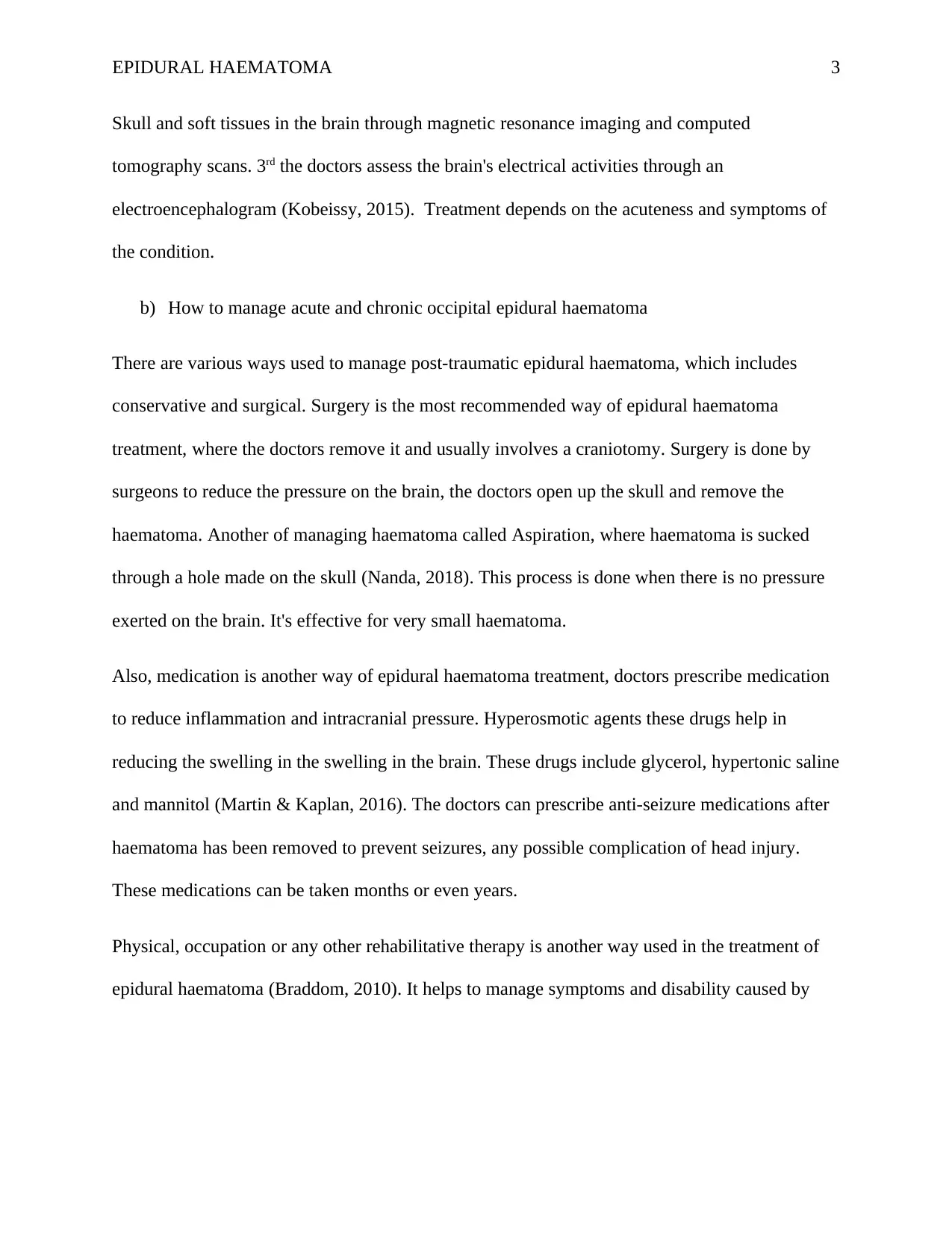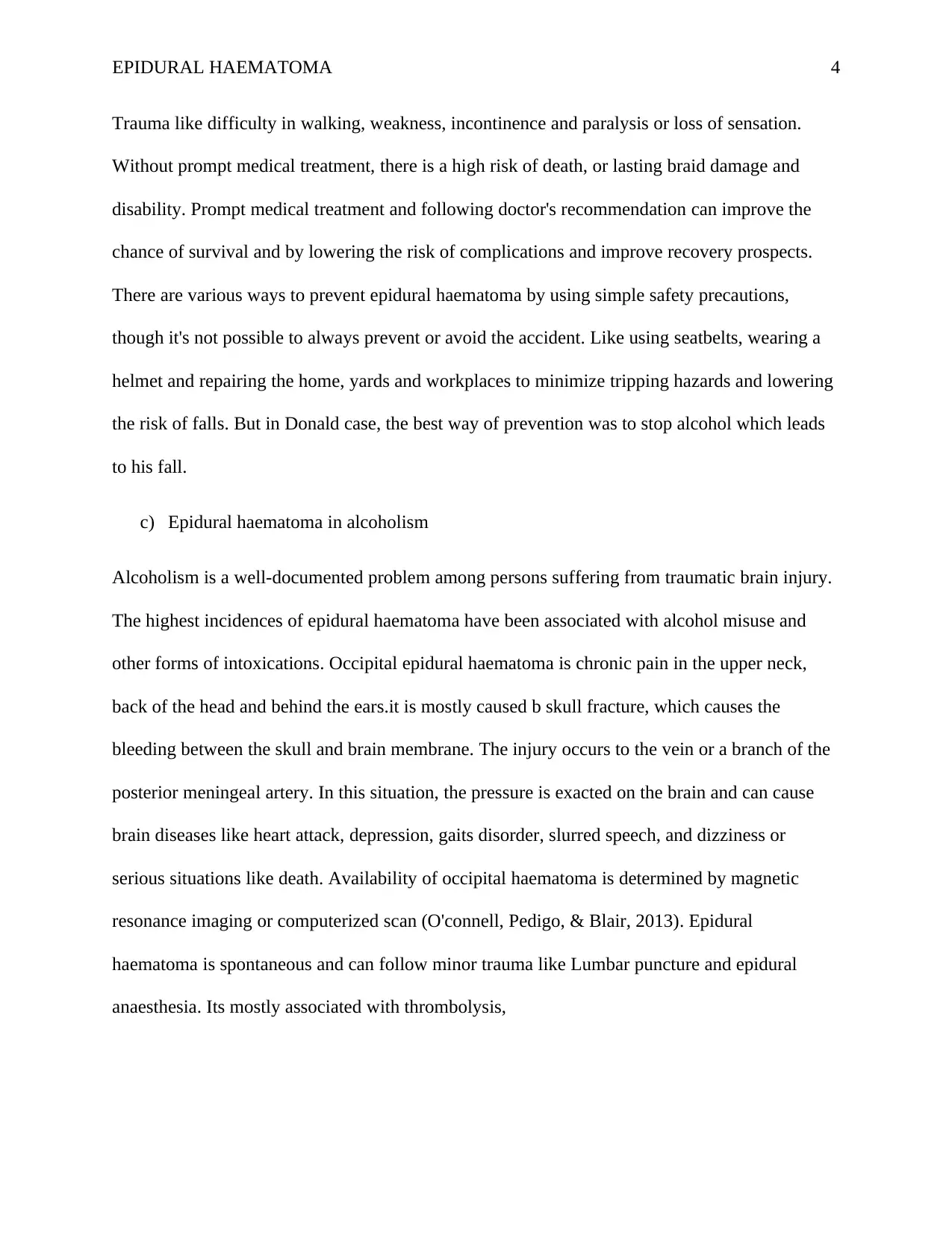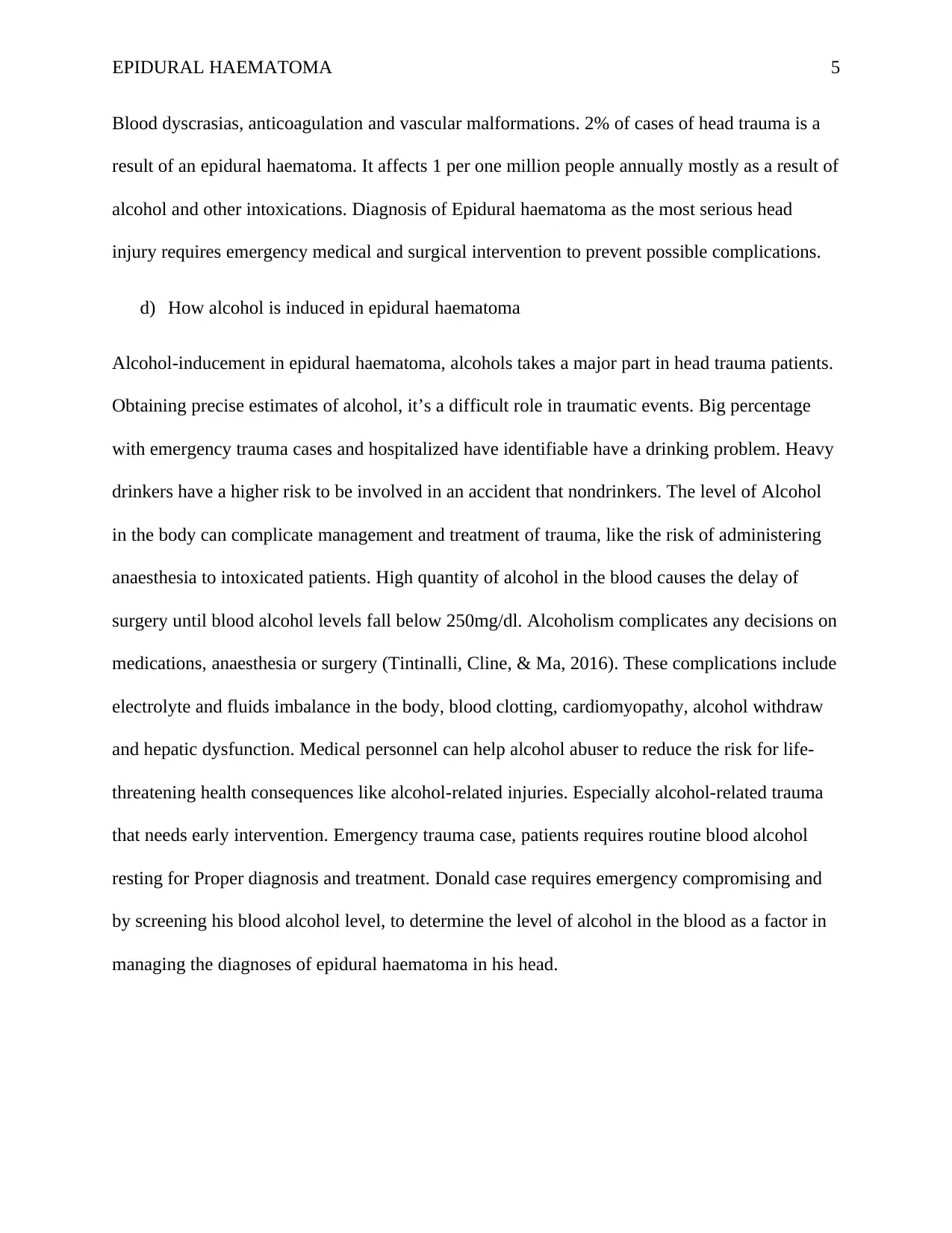Applied Bioscience Report: Epidural Haematoma in Donald De Cruz
VerifiedAdded on 2022/09/28
|7
|1539
|24
Report
AI Summary
This report analyzes the case of Mr. Donald De Cruz, who developed an epidural haematoma following a head trauma. It delves into the pathophysiology of acute and chronic occipital epidural haematomas, detailing the mechanisms of injury and the resulting blood accumulation between the skull and the brain membrane. The report also discusses the management strategies for this condition, including both conservative and surgical approaches such as craniotomy and aspiration, as well as the use of medication, including hyperosmotic agents and anti-seizure drugs. Additionally, it explores the impact of alcoholism on the development and management of epidural haematoma, highlighting the increased risk associated with alcohol misuse and the complications it poses in diagnosis and treatment. The report emphasizes the importance of prompt medical intervention and preventive measures to minimize the risk of severe outcomes.

Running head: EPIDURAL HAEMATOMA 1
Name
Institutional affiliation
Name
Institutional affiliation
Paraphrase This Document
Need a fresh take? Get an instant paraphrase of this document with our AI Paraphraser

EPIDURAL HAEMATOMA 2
EPIDURAL HAEMATOMA
Epidural Haematoma it’s a result from a blow to the side of the head as it occurred to Donald
after falling. It's when haemorrhage occurs between the skull and brain membrane. This situation
causes a mass of blood that forms in a space located between the skull and the membrane that
covers the brain (Ganz, 2017). The brain can bound out of the skull due to head injuries and
trauma. The brain can shift in the skull due to brain swelling which occurs mostly as a result of
an accident. The possible symptoms of include vomiting, confusion, headache, dizziness and
seizures among others.
a) Acute and chronic occipital epidural haematoma
This occipital epidural haematoma mostly occurs as a result of head injuries. Where the brain
suffers damaging blow due to a fall, vehicle accident or contact collision, physical abuse all can
cause brain injury (Kaufman & Milstein , 2012). Most people who are at the risk of being
affected by are older people, alcoholic people have high chances of falling. And those who
experienced trauma in the head and who don’t ware protecting gadgets during contact activities.
There are two types of Epidural haematoma acute which are caused by high-speed, and high
energy is involved, which increasingly severe with the larger haematoma. And chronic subdural
bleeding, its minor head trauma and it develops over some time like days or weeks.
Epidural haematoma is diagnosed by the doctors when then they suspect though the variety of
test to locate it. The diagnosis can be done through the following way, 1st Neurological test this
includes a physical examination and reviewing patient’s medical history 2nd they examine the
EPIDURAL HAEMATOMA
Epidural Haematoma it’s a result from a blow to the side of the head as it occurred to Donald
after falling. It's when haemorrhage occurs between the skull and brain membrane. This situation
causes a mass of blood that forms in a space located between the skull and the membrane that
covers the brain (Ganz, 2017). The brain can bound out of the skull due to head injuries and
trauma. The brain can shift in the skull due to brain swelling which occurs mostly as a result of
an accident. The possible symptoms of include vomiting, confusion, headache, dizziness and
seizures among others.
a) Acute and chronic occipital epidural haematoma
This occipital epidural haematoma mostly occurs as a result of head injuries. Where the brain
suffers damaging blow due to a fall, vehicle accident or contact collision, physical abuse all can
cause brain injury (Kaufman & Milstein , 2012). Most people who are at the risk of being
affected by are older people, alcoholic people have high chances of falling. And those who
experienced trauma in the head and who don’t ware protecting gadgets during contact activities.
There are two types of Epidural haematoma acute which are caused by high-speed, and high
energy is involved, which increasingly severe with the larger haematoma. And chronic subdural
bleeding, its minor head trauma and it develops over some time like days or weeks.
Epidural haematoma is diagnosed by the doctors when then they suspect though the variety of
test to locate it. The diagnosis can be done through the following way, 1st Neurological test this
includes a physical examination and reviewing patient’s medical history 2nd they examine the

EPIDURAL HAEMATOMA 3
Skull and soft tissues in the brain through magnetic resonance imaging and computed
tomography scans. 3rd the doctors assess the brain's electrical activities through an
electroencephalogram (Kobeissy, 2015). Treatment depends on the acuteness and symptoms of
the condition.
b) How to manage acute and chronic occipital epidural haematoma
There are various ways used to manage post-traumatic epidural haematoma, which includes
conservative and surgical. Surgery is the most recommended way of epidural haematoma
treatment, where the doctors remove it and usually involves a craniotomy. Surgery is done by
surgeons to reduce the pressure on the brain, the doctors open up the skull and remove the
haematoma. Another of managing haematoma called Aspiration, where haematoma is sucked
through a hole made on the skull (Nanda, 2018). This process is done when there is no pressure
exerted on the brain. It's effective for very small haematoma.
Also, medication is another way of epidural haematoma treatment, doctors prescribe medication
to reduce inflammation and intracranial pressure. Hyperosmotic agents these drugs help in
reducing the swelling in the swelling in the brain. These drugs include glycerol, hypertonic saline
and mannitol (Martin & Kaplan, 2016). The doctors can prescribe anti-seizure medications after
haematoma has been removed to prevent seizures, any possible complication of head injury.
These medications can be taken months or even years.
Physical, occupation or any other rehabilitative therapy is another way used in the treatment of
epidural haematoma (Braddom, 2010). It helps to manage symptoms and disability caused by
Skull and soft tissues in the brain through magnetic resonance imaging and computed
tomography scans. 3rd the doctors assess the brain's electrical activities through an
electroencephalogram (Kobeissy, 2015). Treatment depends on the acuteness and symptoms of
the condition.
b) How to manage acute and chronic occipital epidural haematoma
There are various ways used to manage post-traumatic epidural haematoma, which includes
conservative and surgical. Surgery is the most recommended way of epidural haematoma
treatment, where the doctors remove it and usually involves a craniotomy. Surgery is done by
surgeons to reduce the pressure on the brain, the doctors open up the skull and remove the
haematoma. Another of managing haematoma called Aspiration, where haematoma is sucked
through a hole made on the skull (Nanda, 2018). This process is done when there is no pressure
exerted on the brain. It's effective for very small haematoma.
Also, medication is another way of epidural haematoma treatment, doctors prescribe medication
to reduce inflammation and intracranial pressure. Hyperosmotic agents these drugs help in
reducing the swelling in the swelling in the brain. These drugs include glycerol, hypertonic saline
and mannitol (Martin & Kaplan, 2016). The doctors can prescribe anti-seizure medications after
haematoma has been removed to prevent seizures, any possible complication of head injury.
These medications can be taken months or even years.
Physical, occupation or any other rehabilitative therapy is another way used in the treatment of
epidural haematoma (Braddom, 2010). It helps to manage symptoms and disability caused by
⊘ This is a preview!⊘
Do you want full access?
Subscribe today to unlock all pages.

Trusted by 1+ million students worldwide

EPIDURAL HAEMATOMA 4
Trauma like difficulty in walking, weakness, incontinence and paralysis or loss of sensation.
Without prompt medical treatment, there is a high risk of death, or lasting braid damage and
disability. Prompt medical treatment and following doctor's recommendation can improve the
chance of survival and by lowering the risk of complications and improve recovery prospects.
There are various ways to prevent epidural haematoma by using simple safety precautions,
though it's not possible to always prevent or avoid the accident. Like using seatbelts, wearing a
helmet and repairing the home, yards and workplaces to minimize tripping hazards and lowering
the risk of falls. But in Donald case, the best way of prevention was to stop alcohol which leads
to his fall.
c) Epidural haematoma in alcoholism
Alcoholism is a well-documented problem among persons suffering from traumatic brain injury.
The highest incidences of epidural haematoma have been associated with alcohol misuse and
other forms of intoxications. Occipital epidural haematoma is chronic pain in the upper neck,
back of the head and behind the ears.it is mostly caused b skull fracture, which causes the
bleeding between the skull and brain membrane. The injury occurs to the vein or a branch of the
posterior meningeal artery. In this situation, the pressure is exacted on the brain and can cause
brain diseases like heart attack, depression, gaits disorder, slurred speech, and dizziness or
serious situations like death. Availability of occipital haematoma is determined by magnetic
resonance imaging or computerized scan (O'connell, Pedigo, & Blair, 2013). Epidural
haematoma is spontaneous and can follow minor trauma like Lumbar puncture and epidural
anaesthesia. Its mostly associated with thrombolysis,
Trauma like difficulty in walking, weakness, incontinence and paralysis or loss of sensation.
Without prompt medical treatment, there is a high risk of death, or lasting braid damage and
disability. Prompt medical treatment and following doctor's recommendation can improve the
chance of survival and by lowering the risk of complications and improve recovery prospects.
There are various ways to prevent epidural haematoma by using simple safety precautions,
though it's not possible to always prevent or avoid the accident. Like using seatbelts, wearing a
helmet and repairing the home, yards and workplaces to minimize tripping hazards and lowering
the risk of falls. But in Donald case, the best way of prevention was to stop alcohol which leads
to his fall.
c) Epidural haematoma in alcoholism
Alcoholism is a well-documented problem among persons suffering from traumatic brain injury.
The highest incidences of epidural haematoma have been associated with alcohol misuse and
other forms of intoxications. Occipital epidural haematoma is chronic pain in the upper neck,
back of the head and behind the ears.it is mostly caused b skull fracture, which causes the
bleeding between the skull and brain membrane. The injury occurs to the vein or a branch of the
posterior meningeal artery. In this situation, the pressure is exacted on the brain and can cause
brain diseases like heart attack, depression, gaits disorder, slurred speech, and dizziness or
serious situations like death. Availability of occipital haematoma is determined by magnetic
resonance imaging or computerized scan (O'connell, Pedigo, & Blair, 2013). Epidural
haematoma is spontaneous and can follow minor trauma like Lumbar puncture and epidural
anaesthesia. Its mostly associated with thrombolysis,
Paraphrase This Document
Need a fresh take? Get an instant paraphrase of this document with our AI Paraphraser

EPIDURAL HAEMATOMA 5
Blood dyscrasias, anticoagulation and vascular malformations. 2% of cases of head trauma is a
result of an epidural haematoma. It affects 1 per one million people annually mostly as a result of
alcohol and other intoxications. Diagnosis of Epidural haematoma as the most serious head
injury requires emergency medical and surgical intervention to prevent possible complications.
d) How alcohol is induced in epidural haematoma
Alcohol-inducement in epidural haematoma, alcohols takes a major part in head trauma patients.
Obtaining precise estimates of alcohol, it’s a difficult role in traumatic events. Big percentage
with emergency trauma cases and hospitalized have identifiable have a drinking problem. Heavy
drinkers have a higher risk to be involved in an accident that nondrinkers. The level of Alcohol
in the body can complicate management and treatment of trauma, like the risk of administering
anaesthesia to intoxicated patients. High quantity of alcohol in the blood causes the delay of
surgery until blood alcohol levels fall below 250mg/dl. Alcoholism complicates any decisions on
medications, anaesthesia or surgery (Tintinalli, Cline, & Ma, 2016). These complications include
electrolyte and fluids imbalance in the body, blood clotting, cardiomyopathy, alcohol withdraw
and hepatic dysfunction. Medical personnel can help alcohol abuser to reduce the risk for life-
threatening health consequences like alcohol-related injuries. Especially alcohol-related trauma
that needs early intervention. Emergency trauma case, patients requires routine blood alcohol
resting for Proper diagnosis and treatment. Donald case requires emergency compromising and
by screening his blood alcohol level, to determine the level of alcohol in the blood as a factor in
managing the diagnoses of epidural haematoma in his head.
Blood dyscrasias, anticoagulation and vascular malformations. 2% of cases of head trauma is a
result of an epidural haematoma. It affects 1 per one million people annually mostly as a result of
alcohol and other intoxications. Diagnosis of Epidural haematoma as the most serious head
injury requires emergency medical and surgical intervention to prevent possible complications.
d) How alcohol is induced in epidural haematoma
Alcohol-inducement in epidural haematoma, alcohols takes a major part in head trauma patients.
Obtaining precise estimates of alcohol, it’s a difficult role in traumatic events. Big percentage
with emergency trauma cases and hospitalized have identifiable have a drinking problem. Heavy
drinkers have a higher risk to be involved in an accident that nondrinkers. The level of Alcohol
in the body can complicate management and treatment of trauma, like the risk of administering
anaesthesia to intoxicated patients. High quantity of alcohol in the blood causes the delay of
surgery until blood alcohol levels fall below 250mg/dl. Alcoholism complicates any decisions on
medications, anaesthesia or surgery (Tintinalli, Cline, & Ma, 2016). These complications include
electrolyte and fluids imbalance in the body, blood clotting, cardiomyopathy, alcohol withdraw
and hepatic dysfunction. Medical personnel can help alcohol abuser to reduce the risk for life-
threatening health consequences like alcohol-related injuries. Especially alcohol-related trauma
that needs early intervention. Emergency trauma case, patients requires routine blood alcohol
resting for Proper diagnosis and treatment. Donald case requires emergency compromising and
by screening his blood alcohol level, to determine the level of alcohol in the blood as a factor in
managing the diagnoses of epidural haematoma in his head.

EPIDURAL HAEMATOMA 6
References
Braddom, R. L. (2010). Physical Medicine and Rehabilitation E-Book. Elsevier Health Sciences.
Retrieved from https://books.google.co.ke/books?
id=dxd4Kcy1StYC&pg=PA561&dq=rehabilitation+therapy+as+epidural+haematoma+m
anagement&hl=en&sa=X&ved=0ahUKEwiduoDYr6blAhWEBGMBHdvxAs4Q6AEIRz
AF#v=onepage&q=rehabilitation%20therapy%20as%20epidural%20haematoma
%20management&f=f
Ganz, J. C. (2017). Intracranial Epidural Bleeding: History, Management, and Pathophysiology.
Elsevier Science. Retrieved from https://books.google.co.ke/books?
id=giYuDwAAQBAJ&dq=Epidural+Haematoma+by+ganz&hl=en&sa=X&ved=0ahUK
Ewj22rfv3qPlAhWeD2MBHTGtBt0Q6AEILTAB
Kaufman, D. M., & Milstein , M. J. (2012). Kaufman's Clinical Neurology for Psychiatrists E-
Book. Elsevier Health Sciences. Retrieved from https://books.google.co.ke/books?
id=7fXzaAT_pwkC&dq=causes+of+Haematoma+by+kaufman+and+milstein+2012&sou
rce=gbs_navlinks_s
Kobeissy, F. H. (2015). Brain Neurotrauma: Molecular, Neuropsychological, and Rehabilitation
Aspects. Taylor & Francis. Retrieved from https://books.google.co.ke/books?
id=zN4vLgEACAAJ&dq=diagnosis+of+epidural+Haematoma+due+to+head+injury+by
+klein+2013&hl=en&sa=X&ved=0ahUKEwitzO2Y6KPlAhWE2uAKHfVpAd4Q6AEI
MzAC
Martin, N. D., & Kaplan, L. J. (2016). Principles of Adult Surgical Critical Care. Springer
publishers.
References
Braddom, R. L. (2010). Physical Medicine and Rehabilitation E-Book. Elsevier Health Sciences.
Retrieved from https://books.google.co.ke/books?
id=dxd4Kcy1StYC&pg=PA561&dq=rehabilitation+therapy+as+epidural+haematoma+m
anagement&hl=en&sa=X&ved=0ahUKEwiduoDYr6blAhWEBGMBHdvxAs4Q6AEIRz
AF#v=onepage&q=rehabilitation%20therapy%20as%20epidural%20haematoma
%20management&f=f
Ganz, J. C. (2017). Intracranial Epidural Bleeding: History, Management, and Pathophysiology.
Elsevier Science. Retrieved from https://books.google.co.ke/books?
id=giYuDwAAQBAJ&dq=Epidural+Haematoma+by+ganz&hl=en&sa=X&ved=0ahUK
Ewj22rfv3qPlAhWeD2MBHTGtBt0Q6AEILTAB
Kaufman, D. M., & Milstein , M. J. (2012). Kaufman's Clinical Neurology for Psychiatrists E-
Book. Elsevier Health Sciences. Retrieved from https://books.google.co.ke/books?
id=7fXzaAT_pwkC&dq=causes+of+Haematoma+by+kaufman+and+milstein+2012&sou
rce=gbs_navlinks_s
Kobeissy, F. H. (2015). Brain Neurotrauma: Molecular, Neuropsychological, and Rehabilitation
Aspects. Taylor & Francis. Retrieved from https://books.google.co.ke/books?
id=zN4vLgEACAAJ&dq=diagnosis+of+epidural+Haematoma+due+to+head+injury+by
+klein+2013&hl=en&sa=X&ved=0ahUKEwitzO2Y6KPlAhWE2uAKHfVpAd4Q6AEI
MzAC
Martin, N. D., & Kaplan, L. J. (2016). Principles of Adult Surgical Critical Care. Springer
publishers.
⊘ This is a preview!⊘
Do you want full access?
Subscribe today to unlock all pages.

Trusted by 1+ million students worldwide

EPIDURAL HAEMATOMA 7
Nanda, A. (2018). Complications in Neurosurgery E-Book. Elsevier Health Sciences. Retrieved
from https://www.worldcat.org/title/complications-in-neurosurgery/oclc/1053984323/
viewport
O'connell, T. X., Pedigo, R. A., & Blair, T. E. (2013). Crush Step 1 E-Book: The Ultimate
USMLE Step 1 Review. Elsevier Health Sciences. Retrieved from
https://books.google.co.ke/books?
id=eUJYAQAAQBAJ&pg=PA490&dq=determining+the+availability+of+epidural+hae
matoma+by+O
%27connell+2013&hl=en&sa=X&ved=0ahUKEwia56bxsKblAhUOmxQKHZiQBjMQ6
AEIMzAC#v=onepage&q=determining%20the%20availability%20of%20epidural
%20hae
Tintinalli, J. E., Cline, D. M., & Ma, J. O. (2016). Tintinalli's Emergency Medicine: A
Comprehensive Study Guide, 8th edition. McGraw Hill Professional. Retrieved from
https://books.google.co.ke/books?
id=FNKLCgAAQBAJ&q=effects+of+alcohol+in+epidural+haematoma+patients+by+Ti
ntinalli+2016&dq=effects+of+alcohol+in+epidural+haematoma+patients+by+Tintinalli+
2016&hl=en&sa=X&ved=0ahUKEwjq2vmcsqblAhWC2eAKHZWfCwsQ6AEIJzAA
Nanda, A. (2018). Complications in Neurosurgery E-Book. Elsevier Health Sciences. Retrieved
from https://www.worldcat.org/title/complications-in-neurosurgery/oclc/1053984323/
viewport
O'connell, T. X., Pedigo, R. A., & Blair, T. E. (2013). Crush Step 1 E-Book: The Ultimate
USMLE Step 1 Review. Elsevier Health Sciences. Retrieved from
https://books.google.co.ke/books?
id=eUJYAQAAQBAJ&pg=PA490&dq=determining+the+availability+of+epidural+hae
matoma+by+O
%27connell+2013&hl=en&sa=X&ved=0ahUKEwia56bxsKblAhUOmxQKHZiQBjMQ6
AEIMzAC#v=onepage&q=determining%20the%20availability%20of%20epidural
%20hae
Tintinalli, J. E., Cline, D. M., & Ma, J. O. (2016). Tintinalli's Emergency Medicine: A
Comprehensive Study Guide, 8th edition. McGraw Hill Professional. Retrieved from
https://books.google.co.ke/books?
id=FNKLCgAAQBAJ&q=effects+of+alcohol+in+epidural+haematoma+patients+by+Ti
ntinalli+2016&dq=effects+of+alcohol+in+epidural+haematoma+patients+by+Tintinalli+
2016&hl=en&sa=X&ved=0ahUKEwjq2vmcsqblAhWC2eAKHZWfCwsQ6AEIJzAA
1 out of 7
Related Documents
Your All-in-One AI-Powered Toolkit for Academic Success.
+13062052269
info@desklib.com
Available 24*7 on WhatsApp / Email
![[object Object]](/_next/static/media/star-bottom.7253800d.svg)
Unlock your academic potential
Copyright © 2020–2025 A2Z Services. All Rights Reserved. Developed and managed by ZUCOL.




